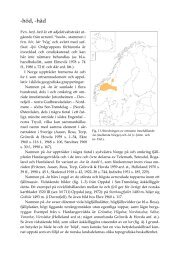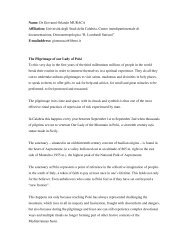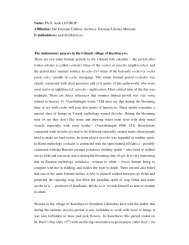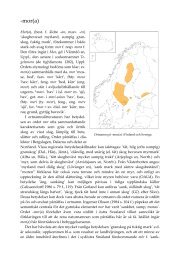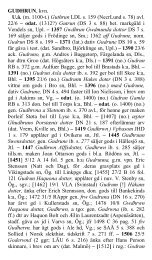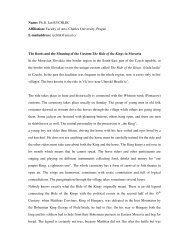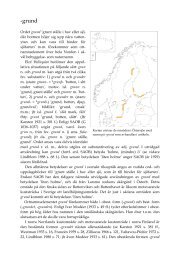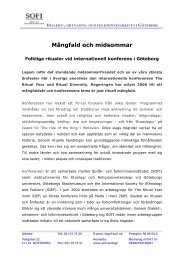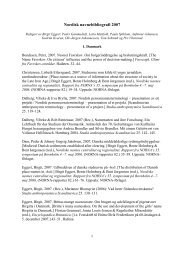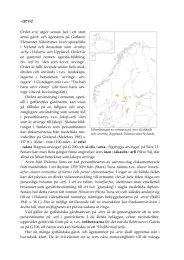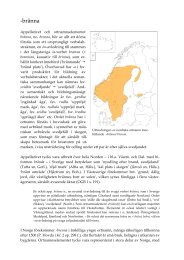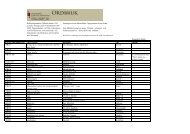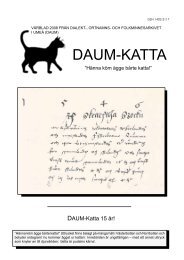Funeral Rites of Udmurts as Beginning and Ending of the Summer ...
Funeral Rites of Udmurts as Beginning and Ending of the Summer ...
Funeral Rites of Udmurts as Beginning and Ending of the Summer ...
You also want an ePaper? Increase the reach of your titles
YUMPU automatically turns print PDFs into web optimized ePapers that Google loves.
Name: Dr Tatiana MINNIYAKHMETOVAAffiliation: Institute for European Ethnology/Folklore, University <strong>of</strong> InnsbruckE-mailaddress: minnijah@hotmail.com<strong>Funeral</strong> <strong>Rites</strong> <strong>of</strong> <strong>Udmurts</strong> <strong>as</strong> <strong>Beginning</strong> <strong>and</strong> <strong>Ending</strong> <strong>of</strong> <strong>the</strong> <strong>Summer</strong> YearWhile <strong>the</strong>re are several ethnic Udmurt groups, I will only be examining one in this paper. In<strong>the</strong> Udmurt folk calendar, <strong>the</strong> <strong>as</strong>tronomic year is divided into two parts, which are consideredseparate years – <strong>the</strong> winter year <strong>and</strong> <strong>the</strong> summer year. The winter year is perceived <strong>as</strong> “closed”<strong>and</strong> <strong>the</strong> summer year is “open”.There is an idiomatic expression that illustrates this concept. When <strong>the</strong> summer year isbeginning, people say “we come out (from winter into summer)”, <strong>and</strong> when <strong>the</strong> winter year isbeginning, people say “we come in (from summer into winter)”. It is a common belief, thattransitional periods <strong>of</strong> se<strong>as</strong>ons <strong>and</strong> years are full <strong>of</strong> supernatural spirits, which visit <strong>the</strong> world<strong>of</strong> human beings. Additionally, <strong>the</strong> dead ancestors <strong>and</strong> <strong>the</strong>ir spirits have a large role in <strong>the</strong>sebeliefs <strong>and</strong> transitional periods. The transitional periods from winter into summer <strong>and</strong> fromsummer into winter are two <strong>of</strong> <strong>the</strong> liminal periods in <strong>the</strong> traditional culture <strong>of</strong> <strong>the</strong> Udmurtpeople <strong>and</strong> funeral rites are held during both <strong>the</strong> spring <strong>and</strong> autumn periods.The ide<strong>as</strong> connected with dead ancestors, <strong>and</strong> hence <strong>the</strong> funeral traditions, are preserved in <strong>the</strong>cultures <strong>of</strong> many peoples. Here, <strong>the</strong> spirits <strong>of</strong> <strong>the</strong> dead ancestors are equated to sacral(considered sacred) <strong>and</strong> people believe that life depends upon <strong>the</strong>m. If <strong>the</strong> ancestors arebenevolent, all will be right <strong>and</strong> well, but <strong>the</strong>y should be propitiated from time to time.Accordingly, <strong>the</strong>re are regulated special periods in day, week, month <strong>and</strong> year whenpeoplemake mention <strong>of</strong> <strong>the</strong>ir ancestors. In this paper, I want to examine two periods <strong>of</strong> <strong>the</strong>year, which take place in spring <strong>and</strong> in autumn, when people commonly celebrate <strong>the</strong>se funeralrites.In <strong>the</strong> periods under examination, <strong>the</strong> ancestors’ spirits “visit” <strong>the</strong>ir relatives, which creates atense <strong>and</strong> stressful social situation. To counteract <strong>the</strong>se periods <strong>of</strong> activity, devotions for <strong>the</strong>dece<strong>as</strong>ed were invented <strong>and</strong> turned into traditional organized rituals whose purpose w<strong>as</strong> toshow honour <strong>and</strong> respect for <strong>the</strong> dece<strong>as</strong>ed ancestors. During one day in this period, people
ake <strong>and</strong> prepare food <strong>and</strong> <strong>the</strong>n go to <strong>the</strong> cemetery to invite <strong>the</strong>ir ancestors to come home <strong>and</strong>celebrate with <strong>the</strong>ir living relatives. Following this celebration, <strong>the</strong> ancestors are shown backto <strong>the</strong> cemetery with a warning to not visit <strong>the</strong> homes <strong>of</strong> <strong>the</strong> living relatives until <strong>the</strong> nextfuneral period.The spring funeral rites are celebrating after <strong>the</strong> commencement <strong>of</strong> <strong>the</strong> summer year, which iscalled “Great Day.” The period <strong>of</strong> <strong>the</strong> autumn funeral rites is after <strong>the</strong> Great Autumn Worship,which is devoted to <strong>the</strong> end <strong>of</strong> summer year, <strong>and</strong> after those is <strong>the</strong> beginning <strong>of</strong> <strong>the</strong> winteryear. An analyse <strong>of</strong> <strong>the</strong> funeral rites demonstrates a reflexive display <strong>of</strong> individual <strong>and</strong>communal identity in a special time when <strong>the</strong> world “changes its appearance”.



